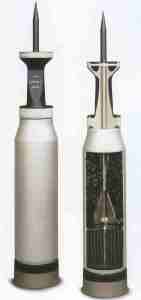Articles >>
Armour Piercing Fin-Stabilised Discarding Sabot Round
Category: Term of the day

A type of kinetic energy ammunition where a sub-calibre penetrator of heavy material is surrounded by a light weight 'pot' or sabot which supports the penetrator in the barrel. The use of the sabot ensures that the largest possible base area is presented to the propellant gases over which pressure can be exerted. The sabot falls to the ground a few hundred metres from the barrel, leaving the sub-calibre penetrator to continue to the target. A penetrator of a dense material (high grade steel, tungsten or depleted uranium) is surrounded by a light-weight 'pot' or circular support, the object of which is to present the largest possible base area within the barrel, over which the propellant gas can exert pressure. The projectile is accelerated very quickly up the barrel and once it exits from the muzzle the air resistance causes the 'pot' to fall off allowing the smaller diameter penetrator to continue towards the target. The penetrator normally has a ballistically shaped outer shell or cap to make it more aerodynamic in flight. This ballistic casing normally shatters on contact with the armour, leaving the solid core to penetrate. Depth of penetration at the target will depend not only on the residual energy of the shot but also on its shape and size. The shape of the curve at the head of the penetrator (the ogive) is most important as it must not only be able to pierce the armour but must 'turn into' it to reduce the advantage of sloped armour and not ricochet. Ideally, the penetrator must not break up, should pass through taking as much armour material with it as possible and should break up inside the tank and not exit on the far side, expending all its energy within the vehicle. If, for a given mass, the diameter of the penetrator is reduced and its length is increased, then for the same residual velocity, it will penetrate a greater thickness of armour as it will be expending its energy over a smaller cross-sectional area. The ratio of the length-to-diameter is called the 'slenderness' ratio or length/diameter ratio and although a projectile with a ratio in excess of 7:1 cannot be spin-stabilised it is not until they reach a ratio of approximately 20:1 that they can be called 'long rods'. The long rod penetrator has been the most significant advance in kinetic energy ammunition in recent years though the idea itself is far from new. The most famous application of the principal of the long rod penetrator was the arrow used by the medieval archers to defeat the armoured knight. |
Problems of Russian Vacuum APFSDS-T projectile
25.01.2019
Otokar debuts its Light Tank in Paris
19.06.2018
BAE Systems receives U.S. Army contract to begin M109A7 full-rate production
23.12.2017
Otokar is now closer to its users in the Gulf Region
25.02.2017
C76A1(FP105)APFSDS-T (Projectile)
40 APFSDS-T Mk II IM (Projectile)
Discuss
Records 1 to 8 of 8
Post |
|
| Misima 15:56 01.08.2006 |
It is doubtful that this metal stick can go through thick armor plate. |
| Fabian 18:21 01.08.2006 |
It goes thru armor like hot needle goes thru a piece of butter. |
| Azam 10:40 02.08.2006 |
This type of ammunition is good because it can not be stopped by explosive reactive armour. |
| Ayed 09:24 03.08.2006 |
That is not exactly true. The latest ERA packages can reduce the penetration of the APFS rounds too. |
| Fabian 13:36 03.08.2006 |
The companies who develop ERA claim that it can stop any projectile, and the companies who develop projectiles claim that they can penetrate any ERA. Where is the truth to be found? |
| Misima 16:33 04.08.2006 |
In the race for quality there is no finish line. But this type of projectile does seem to be too primitive and antiquated. |
| Huda 15:22 10.08.2006 |
It is not antiquated. It is the most efficient projectile to defeat modern armour. |
| Dai 18:58 15.08.2006 |
Huda is correct - it is, due to the incredible desity of the round, the most effective way of penetrating MBT battle armour. HEAT sheels may be more accurate, cheaper and just as effective against light armoured vehicles, but against an MBT HEat shells can struggle, especially at extended ranges. There was instances, in the '91 Gulf War, when Sabot shells, fired from UK Challenger II and US Abrams MBTS, penetrated not only the steel plate of T-72 turret armour, BUT also through the concrete berms that the T-72's were sheltering behind. However, Sabot shells are not useful in any circumstance - another example of the Gulf War in '91, an Iraqi bus was fired upon by US abrams tanks - recording around 5 confirmed hits, the bus just drove on...if the bus had been engaged with HEAT, or even a 20/30mm cannon, the results would be a lot different. And o the subject of ERA - ERA is designed to explode upon contact of a HEAT shell - the ERA (Explosive Reactive Armour) expoding nagantes the force of the HEATs explosion. A Sabot shell, being simkply in effect a long metal dart usng kinetic engery to penertrate, is not effected by the ERA - so in answer to that question, no, ERA will not be effective against the Sabot. Very little is... |
